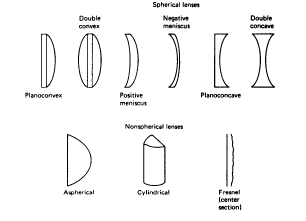go to WEEK 3 Problem 1 2 3 4 5 Demo Online Course Support
MSE 5090: Case Studies in Material Selection
Week 3 - Material Selection Process
Weighted Property Index Methods - Problem 4
go to WEEK 3 Problem 1 2 3 4 5 Demo Online Course Support
MSE 5090: Case Studies in Material Selection
Week 3 - Material Selection Process
Weighted Property Index Methods - Problem 4
Enumerate the advantages and disadvantages of polymers as materials for use in various optical applications. Include in the presentation details of the relevant properties of some candidate optical polymeric materials.
DISADVANTAGES
· Low abrasion resistance: scratch-resistant
coatings are, however, available for some optical polymers, such as polymethylmethacrylate
(PMMA) and polycarbonate, but the coatings are expensive and necessary
in only a few applications, such as ophthalmic lenses.
 |
Figure Q4.1 The curved surfaces of spherical and nonspherical lenses. |
 |
Figure Q4.2 Combination of spherical and aspherical contours in a single lens. |
· Poor tolerance of large temperature
functuations; this, though, might not be a serious limitation because most
optical systems do not normally operate in temperatures beyond the thermal
limits of most optical polymers
· Narrow choice of raw materials—this
means less design freedom because of a restricted range of refractive indices
and dispersions (dispersion is the variation of refractive index with wavelength
and is expressed by the Abbe value);* however, creative use of polymer
aspherics (Fig. Q4.2) often compensates for this drawback.
CANDIDATE OPTICAL POLYMERS
The principal ones are as follows:
· Polymethylmethacrylate (PMMA) is
very hard, abrasion-resistant, mechanically stable, and very widely used.
· Polystyrene is also a widely used
optical polymer, but the molding cost far outstrips the resin cost. It
can be used for lens designs requiring thin cross sections, thereby reducing
resin cost and offsetting the high processing cost. Its low Abbe value
allows it to be used in color-corrected designs.
· Polycarbonate is a very tough polymer
that gives good performance over a wide temperature range (—
140°C
to 120°C). Its high impact strength makes it particularly suited for
use in streetlight lenses, construction lights, and roadwork warning lights.
Because the polymer cannot be easily machined, injection molding is almost
invariably used.
· A copolymer consisting of 70 wt
% polystyrene and 30 wt % PMMA. Its refractive index is difficult to control
because it is a composite material, but many optical designs compensate
for this limitation. This copolymer is particularly suitable for thin lens
systems.
The relevant properties of these optical polymers are given in Table
Q4. 1. Other candidate optical polymers and their properties are presented
in Table Q4.2.
|
|
|
|
|
Polystyrene Copolymer |
| Refractive
index
At np = 0.589 mm At nF 0.486 mm At nc 0.656 mm |
1.491
1.497 1.498 |
1.590
1.604 1.584 |
1.593 1.576 |
1.574 1.558 |
| Critical angle (°) |
|
|
|
|
| Coefficient of thermal expansion (10-6 °C -1) |
|
|
|
|
|
|
|
|
|
|
| Density (kg m -3) |
|
|
|
|
| Hardness. Rockwell M(kg mm -2) |
|
|
|
|
| Izod impact
strength
(J m-1 notch) |
|
|
|
|
| Dielectric
strength
(MV m -1) |
|
|
|
|
| Dielectric
constant
At 60 Hz At 1 MHz |
2.2 |
2.46 |
2.88 |
2.90 |
| Power loss
factor
At 60 Hz At 1 MHz |
0.03 |
0.0002 |
0.0075 |
0.013 |
| Volume electrical
resistivity (Wm) |
|
|
|
|
TABLE 04.2 CHARACTERISTICS OF SOME OPTICAL POLYMERS
|
|
Constant at 10 kHz |
Strength (MPa) |
Strength (J m-1 notch) |
(kg m-3) |
Expansion (10-6 ° C-1) |
| Styrene acrylonitrile |
|
|
|
|
|
|
|
|
|
|
|
|
| Polysulfone |
|
|
|
|
|
aAt break point.
bAt yield point.REFERENCE: 1.Lewis , G. Selection of Engineering Materials, Prentice Hall , 1990, pp 258-260

Last update 9-12-98